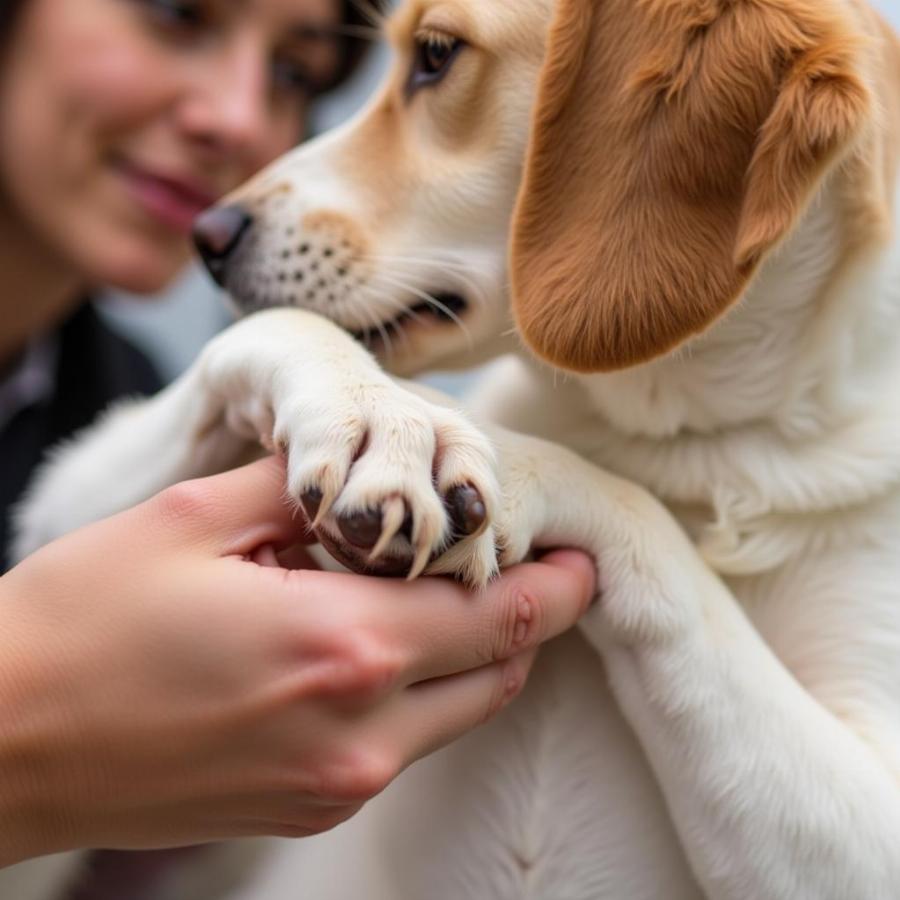Dog foot pad blisters can be a painful and concerning issue for our furry friends. Understanding the causes, symptoms, and treatment options for dog foot pad blister is crucial for any responsible pet owner. This article provides a comprehensive guide to help you navigate this paw-some problem and keep your canine companion happy and healthy.
Understanding Dog Foot Pad Blisters
Dog foot pad blisters are essentially small pockets of fluid that form on the surface of the paw pads. They can be caused by a variety of factors, ranging from hot pavement to rough terrain. Recognizing the signs of a dog foot pad blister is the first step in providing effective treatment. Common symptoms include limping, excessive licking of the paws, and visible redness or swelling on the paw pads.
Causes of Dog Foot Pad Blisters
Several factors can contribute to the development of dog foot pad blisters. Hot pavement during the summer months is a common culprit. Walking or running on rough surfaces like gravel or asphalt can also cause friction and lead to blisters. Additionally, allergies, infections, and autoimmune diseases can also manifest as blisters on the paw pads.
Hot Pavement and Dog Paws
Hot pavement can quickly burn a dog’s sensitive paw pads, leading to blisters. It’s essential to avoid walking your dog during the hottest parts of the day, especially in the summer. If the pavement is too hot for your hand, it’s definitely too hot for your dog’s paws. Consider using dog booties, especially for breeds with sensitive paws or during extended outdoor activities.
Rough Terrain and Paw Pad Injuries
Hiking or running on rough terrain can also cause blisters on a dog’s paws. Sharp rocks, sticks, and uneven surfaces can create friction and pressure points, leading to blisters and other paw injuries. Be mindful of the terrain you choose for your dog walks and consider using dog booties for extra protection, especially in challenging environments.
Treating Dog Foot Pad Blisters
If your dog develops a foot pad blister, prompt treatment is crucial to prevent infection and further complications. Clean the affected paw with mild soap and water. Apply a pet-safe antiseptic and cover the blister with a loose bandage to prevent further irritation. Consult with your veterinarian for appropriate pain management and to rule out any underlying medical conditions.
Home Remedies for Dog Paw Blisters
While minor blisters can often be managed at home, it’s essential to consult your veterinarian for persistent or severe blisters. Applying a cold compress can help reduce swelling and inflammation. Aloe vera gel can also provide soothing relief and promote healing. Avoid popping the blister, as this can increase the risk of infection.
 Checking a dog's paw for injuries
Checking a dog's paw for injuries
Preventing Dog Foot Pad Blisters
Prevention is always better than cure. Taking proactive steps can significantly reduce the risk of your dog developing foot pad blisters. Avoid walking your dog on hot pavement, especially during peak sun hours. Use dog booties for added protection on rough terrain or hot surfaces. Regularly inspect your dog’s paws for any signs of injury or irritation.
When to Seek Veterinary Care
While minor blisters can often be managed at home, it’s crucial to seek veterinary care if the blister is large, deep, bleeding, or shows signs of infection. Your veterinarian can provide appropriate treatment and rule out any underlying medical conditions.
Conclusion
Dog foot pad blisters can be a painful nuisance, but with proper care and prevention, you can keep your canine companion’s paws healthy and happy. By understanding the causes, symptoms, and treatment options for dog foot pad blisters, you can provide the best possible care for your furry friend. Remember to always consult with your veterinarian for any concerns about your dog’s health.
FAQ:
- What are the common signs of a dog foot pad blister? Limping, excessive licking of the paws, redness, swelling, and visible blisters on the pads.
- Can I pop my dog’s blister? No, avoid popping the blister as it can increase the risk of infection.
- What should I do if my dog’s blister is bleeding? Clean the wound gently, apply pressure to stop the bleeding, and consult your veterinarian immediately.
- Are there any home remedies for dog paw blisters? Cold compresses and aloe vera gel can provide soothing relief, but always consult your vet for severe cases.
- How can I prevent dog foot pad blisters? Avoid hot pavement, use dog booties for protection, and regularly inspect your dog’s paws.
Related Articles You Might Find Helpful:
Beaut Dogs: Your Ultimate Resource for Canine Care
Beaut Dogs is your go-to resource for all things dog-related. We provide reliable, helpful, and in-depth information about the world of canines, from breed characteristics and care tips to health advice and product recommendations. When you need support, contact us at Email: [email protected] to get detailed and accurate answers from Beaut Dogs.